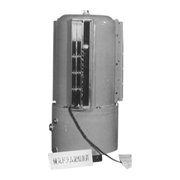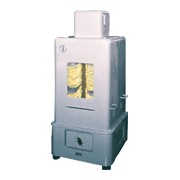In 1958, Fuji Communications Equipment Manufacturing Co. (currently Fujitsu Ltd.) completed the D101, their first magnetic drum unit for computers. In terms of performance, this equipment had 675,000 bits of memory capacity and a maximum access time of 21ms.
The biggest issues for magnetic drum units were how to reduce circumferential vibration of a drum rotating at high speed (eccentricity on the same circumference of 5 microns or less), and how to maintain that precision during long-term continuous operation. This magnetic drum was made by coating iron oxide powder to a thickness of about 20 microns onto a rotating cylinder made of non-magnetic material (aluminum). Five magnetic heads (using molybdenum permalloy as the core material) were integrated into a single set, and 75 of these sets were arranged in a line at a 5mm pitch. And these arrays were placed 1.67mm apart at 3 points separated by 120° in the circumferential direction. As a total, the D101 had 225 sets of integrated magnetic heads.
A number of models were developed later with improvements such as introducing independent magnetic heads for clock, and greater capacity. In the D101J, a maximum capacity of 1 million bits was achieved by increasing the number of magnetic heads for data to 300, and realizing a recording density of 3-4bit/mm in the circumferential direction, and a pitch of approximately 1.2mm in the cylinder length direction. The improvement of the density and the pitch was done by making the 5 heads for clock independent.
This magnetic drum model for computer was first used as a main memory device (4000 words) (Note) in the FACOM 200 Parametron computer, but the FACOM 200 was terminated while still in the experimental stage. The D101 was first used in actual practice in the FACOM 222-first transistor computer from Fuji Communications Equipment Manufacturing Co..
(Note) One word of the FACOM 200 was 60 bits, so the unit can be regarded as having used 240,000 bits of memory capacity.
| D101 | D101c | D101J | ||
|---|---|---|---|---|
| Completion date | 1958 | 1959 | 1960 | |
| Rotor dimensions | 284ø×380 mm | 284ø×360 mm | 284ø×424 mm | |
| Rotation speed | 2,900 rpm(50Hz) | 2,900 rpm(50Hz)/ 3,450 rpm(60Hz) |
2,900 rpm(50Hz) | |
| Rotation delay time | Max. 21 ms | Average 10 ms | ||
| Number of heads | For general purpose | 225 | 225 | 300 |
| For clock | - | 5 | 5 | |
| Capacity | 675,000bits | 900,000bits | 1 million bits | |
| External dimensions (mm) | 870(H)×400(ø) | - | 460(W)×520(D)×1,100(H) | |



